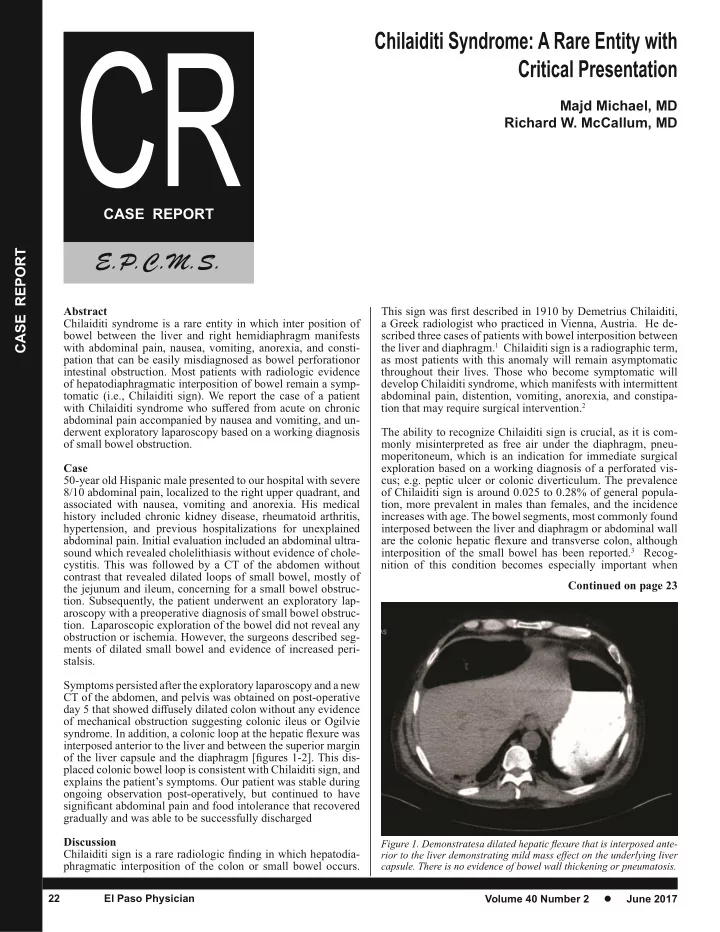

Majd Michael, MD Richard W. McCallum, MD CASE REPORT Abstract This sign was first described in 1910 by Demetrius Chilaiditi, Chilaiditi syndrome is a rare entity in which inter position of a Greek radiologist who practiced in Vienna, Austria. He de- bowel between the liver and right hemidiaphragm manifests scribed three cases of patients with bowel interposition between with abdominal pain, nausea, vomiting, anorexia, and consti- the liver and diaphragm. 1 Chilaiditi sign is a radiographic term, pation that can be easily misdiagnosed as bowel perforationor as most patients with this anomaly will remain asymptomatic intestinal obstruction. Most patients with radiologic evidence throughout their lives. Those who become symptomatic will of hepatodiaphragmatic interposition of bowel remain a symp- develop Chilaiditi syndrome, which manifests with intermittent tomatic (i.e., Chilaiditi sign). We report the case of a patient abdominal pain, distention, vomiting, anorexia, and constipa- with Chilaiditi syndrome who suffered from acute on chronic tion that may require surgical intervention. 2 abdominal pain accompanied by nausea and vomiting, and un- derwent exploratory laparoscopy based on a working diagnosis The ability to recognize Chilaiditi sign is crucial, as it is com- of small bowel obstruction. monly misinterpreted as free air under the diaphragm, pneu- moperitoneum, which is an indication for immediate surgical Case exploration based on a working diagnosis of a perforated vis- 50-year old Hispanic male presented to our hospital with severe cus; e.g. peptic ulcer or colonic diverticulum. The prevalence 8/10 abdominal pain, localized to the right upper quadrant, and of Chilaiditi sign is around 0.025 to 0.28% of general popula- associated with nausea, vomiting and anorexia. His medical tion, more prevalent in males than females, and the incidence history included chronic kidney disease, rheumatoid arthritis, increases with age. The bowel segments, most commonly found hypertension, and previous hospitalizations for unexplained interposed between the liver and diaphragm or abdominal wall abdominal pain. Initial evaluation included an abdominal ultra- are the colonic hepatic flexure and transverse colon, although sound which revealed cholelithiasis without evidence of chole- interposition of the small bowel has been reported. 3 Recog- cystitis. This was followed by a CT of the abdomen without nition of this condition becomes especially important when contrast that revealed dilated loops of small bowel, mostly of Continued on page 23 the jejunum and ileum, concerning for a small bowel obstruc- tion. Subsequently, the patient underwent an exploratory lap- aroscopy with a preoperative diagnosis of small bowel obstruc- tion. Laparoscopic exploration of the bowel did not reveal any obstruction or ischemia. However, the surgeons described seg- ments of dilated small bowel and evidence of increased peri- stalsis. Symptoms persisted after the exploratory laparoscopy and a new CT of the abdomen, and pelvis was obtained on post-operative day 5 that showed diffusely dilated colon without any evidence of mechanical obstruction suggesting colonic ileus or Ogilvie syndrome. In addition, a colonic loop at the hepatic flexure was interposed anterior to the liver and between the superior margin of the liver capsule and the diaphragm [figures 1-2]. This dis - placed colonic bowel loop is consistent with Chilaiditi sign, and explains the patient’s symptoms. Our patient was stable during ongoing observation post-operatively, but continued to have significant abdominal pain and food intolerance that recovered gradually and was able to be successfully discharged Discussion Chilaiditi sign is a rare radiologic finding in which hepatodia - phragmatic interposition of the colon or small bowel occurs. 22 El Paso Physician Volume 40 Number 2 � June 2017
(Continued) CASE REPORT performing interventional procedures such as hepatic biopsy and percutaneous gallbladder drainage. Suspensory ligaments and fixation of the colon normally pre - vent inter position of the colon between the liver and diaphragm. Hence, any variations in normal anatomy can lead to the inter- position of the colon. Anatomic distortions may predispose pa- tients to the development of Chilaiditi sign, including decreased liver dimensions, elongation of the ligamentous suspension of the liver, and redundancy of the colon. Other described anomalies as- sociated with this sign are right hepatic lobe segmental agenesis, relaxation or a genesis of the mesentery suspensory ligaments, and hypermobile transverse mesentery and transverse colon. An- other predisposition to Chilaiditi sign is elongation of the lower thoracic cage in chronic obstructive pulmonary disease, leading to a broader space where colonic interposition can occur. The prevalence of Chilaiditi sign in cirrhotic patients without ascites is much higher than in the general population, possibly explained by the smaller volume of the cirrhotic liver. 4 A retrospective study of the relationship between Chilaiditi syndrome and obesity con- cluded that obesity may be a contributing factor in the etiology of Chilaiditi syndrome, and the difference in fat deposition be - tween men and women may account for the increased prevalence in men, who are more likely to have “central” or visceral organ Figure 2. Diffusely dilated colon with interposed colonic loop behind and obesity. 5 Mental illness and schizophrenia may also increase in- superior to the liver, and no evidence of mechanical obstruction cidence of Chilaiditi sign. 6 Continued on page 24 El Paso Physician 23 Volume 40 Number 2 � June 2017
Recommend
More recommend